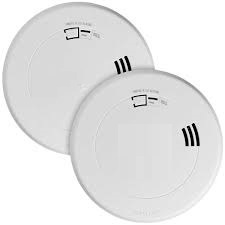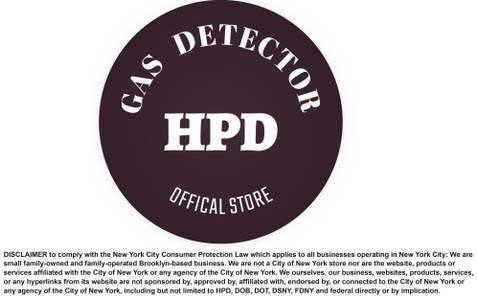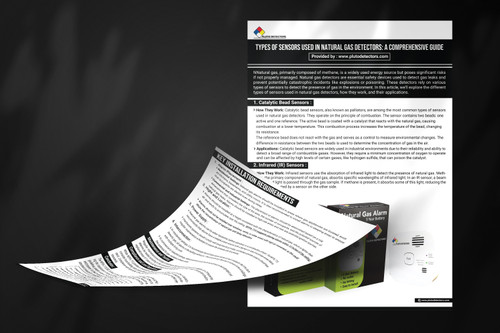Types of Sensors Used in Natural Gas Detectors: A Comprehensive Guide
Natural gas, primarily composed of methane, is a widely used energy source but poses significant risks if not properly managed. Natural gas detectors are essential safety devices used to detect gas leaks and prevent potentially catastrophic incidents like explosions or poisoning. These detectors rely on various types of sensors to detect the presence of gas in the environment. In this article, we'll explore the different types of sensors used in natural gas detectors, how they work, and their applications.
- Catalytic Bead Sensors
How They Work: Catalytic bead sensors, also known as pellistors, are among the most common types of sensors used in natural gas detectors. They operate on the principle of combustion. The sensor contains two beads: one active and one reference. The active bead is coated with a catalyst that reacts with the natural gas, causing combustion at a lower temperature. This combustion process increases the temperature of the bead, changing its resistance.
The reference bead does not react with the gas and serves as a control to measure environmental changes. The difference in resistance between the two beads is used to determine the concentration of gas in the air.
Applications: Catalytic bead sensors are widely used in industrial environments due to their reliability and ability to detect a broad range of combustible gases. However, they require a minimum concentration of oxygen to operate and can be affected by high levels of certain gases, like hydrogen sulfide, that can poison the catalyst.
- Infrared (IR) Sensors
How They Work: Infrared sensors use the absorption of infrared light to detect the presence of natural gas. Methane, the primary component of natural gas, absorbs specific wavelengths of infrared light. In an IR sensor, a beam of infrared light is passed through the gas sample. If methane is present, it absorbs some of this light, reducing the intensity detected by a sensor on the other side.
By measuring the reduction in light intensity, the concentration of methane can be calculated. This method does not require oxygen and is not affected by poisons, making IR sensors particularly robust.
Applications: Infrared sensors are used in environments where catalytic bead sensors might fail, such as in areas with low oxygen levels or high concentrations of interfering gases. They are also favored in applications requiring long-term stability and low maintenance, such as in continuous monitoring systems.
- Semiconductor Sensors
How They Work: Semiconductor sensors, also known as metal oxide semiconductor (MOS) sensors, operate based on the change in conductivity of a semiconductor material when exposed to natural gas. The sensor surface is typically coated with a metal oxide, such as tin dioxide. When methane interacts with the sensor surface, it causes a change in the conductivity of the material.
This change in conductivity is measured and used to determine the concentration of gas in the air. Semiconductor sensors are sensitive to a wide range of gases and can detect very low concentrations.
Applications: Semiconductor sensors are often used in residential gas detectors due to their low cost and high sensitivity. They are also used in some industrial applications, although they can be prone to false alarms due to their sensitivity to humidity and temperature changes.
- Electrochemical Sensors
How They Work: Electrochemical sensors are typically used to detect toxic gases, but they can also be adapted for natural gas detection. These sensors consist of an electrolyte and electrodes. When natural gas comes into contact with the sensor, it undergoes a chemical reaction, producing an electrical current proportional to the gas concentration.
Electrochemical sensors are highly selective and can be designed to respond only to specific gases. They are also relatively low power, making them suitable for battery-powered detectors.
Applications: While less common in natural gas detectors, electrochemical sensors are used in applications where precise detection of specific gas components, such as methane, is required. They are often found in portable gas detectors used by safety inspectors and first responders.
- Ultrasonic Sensors
How They Work: Ultrasonic sensors detect natural gas leaks by listening for the sound of gas escaping under pressure. Unlike other sensors that detect the presence of gas itself, ultrasonic sensors are designed to pick up the ultrasonic sound waves generated by gas escaping from a leak.
These sensors are non-invasive and do not require direct contact with the gas. They can detect leaks in high-noise environments and are unaffected by wind or gas concentration.
Applications: Ultrasonic sensors are used in industrial settings where high-pressure gas systems are in use. They are particularly useful for detecting leaks in pipelines and other equipment where gas may escape through small cracks or fittings.
Conclusion
Natural gas detectors are critical for ensuring safety in both residential and industrial environments. The choice of sensor depends on the specific requirements of the application, including sensitivity, environmental conditions, and the presence of other gases. Catalytic bead, infrared, semiconductor, electrochemical, and ultrasonic sensors each offer unique advantages and are chosen based on the specific needs of the detection system.
Understanding the different types of sensors available can help in selecting the most appropriate natural gas detector for a given situation, ensuring that gas leaks are detected quickly and effectively, thereby preventing accidents and saving lives.
DISCLAIMER these codes may not be the most recent version. The State / federal or other regulation department may have more current or accurate information. We make no warranties or guarantees about the accuracy, completeness, or adequacy of the information contained on this site or the information linked to on the state site. Please check official sources. The requirements for detector are determined by intended use and by applicable regulation. The BUYER is responsible for determining the appropriate detector needed. WE make no warranty or representation of suitability of a detector to any code or for any specific application. IT IS THE CUSTOMER'S RESPONSIBILITY TO ENSURE THAT THE DETECTORS THE CUSTOMER ORDERS ARE IN COMPLIANCE WITH ALL STATE, FEDERAL, LOCAL, AND MUNICIPAL LAWS. Please review terms and conditions prior to purchase. For more information about what is required, see the laws that are referenced and the rules applicable to your city and state. This page is for informational purposes only and is not intended as legal advice, professional advice or a statement of law. You may wish to consult with an attorney.
------------------------
Legal Disclaimer for Our Site
Welcome to Our Site. By accessing, browsing, or using this website, you agree to comply with and be bound by the following terms and conditions of use, which, together with our Privacy Policy, govern Our Site’s relationship with you. If you disagree with any part of these terms and conditions, please do not use our website.
- Compliance with New York City Consumer Protection Law
- To comply with the New York City Consumer Protection Law, which applies to all businesses operating in New York City:
We are a small family-owned and family-operated Brooklyn-based business. We are not a City of New York store nor are the website, products, or services affiliated with the City of New York or any agency of the City of New York.
We, our business, websites, products, services, or any hyperlinks from our website are not sponsored by, approved by, affiliated with, endorsed by, or connected to the City of New York or any agency of the City of New York, including but not limited to the HPD, DOB, DOT, DSNY, FDNY, or any federal entity, directly or by implication.
- Website Content
- The content on this website is provided for general informational purposes only. While we strive for accuracy, Our Site makes no warranties or representations regarding the completeness, accuracy, or reliability of the information provided.
- All content is subject to change without notice and is provided "as is."
- No Professional Advice
- The information provided on Our Site does not constitute legal, financial, or professional advice. You should seek independent advice from qualified professionals for your specific situation.
- Requirements for Detectors
- The requirements for detectors are determined by the intended use and applicable regulations. The buyer is responsible for determining the appropriate detector needed.
- Our Site makes no warranty or representation of the suitability of a detector to any code or for any specific application.
- It is the customer’s responsibility to ensure that the products they order comply with all applicable local, state, and federal laws before making a purchase.
- Our Site is not liable for any non-compliance with laws or regulations regarding the products purchased.
- Please review our terms and conditions prior to purchase.
- Limitation of Liability
- To the fullest extent permitted by law, Our Site disclaims all liability for any damages, including but not limited to direct, indirect, incidental, consequential, or punitive damages, arising from your access to or use of this site.
- We are not responsible for any errors, omissions, interruptions, delays, or defects in the operation of the website.
- Third-Party Links
- Our Site may include links to third-party websites for your convenience. These links do not signify our endorsement of the content, products, or services offered on these third-party websites. We are not responsible for the accuracy, legality, or content of any linked websites.
- Intellectual Property
- All content on Our Site, including but not limited to text, images, graphics, logos, and designs, is the property of Our Site or its content suppliers and is protected by copyright, trademark, and other intellectual property laws.
- Unauthorized use or reproduction of the content may violate applicable laws and is strictly prohibited.
- User-Generated Content
- Users may be permitted to post, upload, or share content on Our Site. By doing so, you grant us a perpetual, non-exclusive, royalty-free, and irrevocable right to use, modify, distribute, and display such content in connection with our website and business.
- Users are solely responsible for the content they upload and agree not to post any material that is unlawful, defamatory, or infringes on the rights of others.
- Disclaimer of Warranties
- Our Site makes no warranties, express or implied, regarding the operation of the website or the content, materials, or products included on the website. We disclaim all warranties, including but not limited to implied warranties of merchantability and fitness for a particular purpose.
- These codes may not be the most recent version. The State / federal or other regulation department may have more current or accurate information. We make no warranties or guarantees about the accuracy, completeness, or adequacy of the information contained on this site or the information linked to on the state site. Please check official sources.
- For more information about what is required, see the laws that are referenced and the rules applicable to your city and state. This page is for informational purposes only and is not intended as legal advice, professional advice or a statement of law. You may wish to consult with an attorney.
- Indemnification
- You agree to indemnify, defend, and hold harmless Our Site , our company, its employees, agents, and affiliates from any claims, damages, losses, or expenses (including attorney’s fees) arising from your use of the website or violation of these terms.
- Privacy Policy
- Your use of Our Site is subject to our Privacy Policy. Please review it to understand our practices regarding the collection and use of your information.
- Governing Law
- This disclaimer and any disputes arising from your use of Our Site are governed by the laws of Brooklyn NY, without regard to its conflict of law principles. By using this website, you consent to the exclusive jurisdiction of the courts in Brooklyn NY.
- Changes to This Disclaimer
- We reserve the right to update or modify this disclaimer at any time without prior notice. Continued use of Our Site following any changes indicates your acceptance of the updated disclaimer.
- Contact Information
- For questions or concerns regarding this disclaimer, please contact us at:
- Email: info@plutodetectors.nyc
- Product Warranty
- Our Site does not provide any product warranties.
- Any issues, defects, or warranty claims must be directed to the product manufacturer.
- Our Site act solely as a reseller of the products listed and makes no guarantees regarding product performance, reliability, or compliance.
DISCLAIMER to comply with the New York City Consumer Protection Law which applies to all businesses operating in New York City: We are small family-owned and family-operated Brooklyn-based business. We are not a City of New York store nor are the website, products or services affiliated with the City of New York or any agency of the City of New York. We ourselves, our business, websites, products, services, or any hyperlinks from its website are not sponsored by, approved by, affiliated with, endorsed by, or connected to the City of New York or any agency of the City of New York, including but not limited to HPD, DOB, DOT, DSNY, FDNY and federal directly or by implication.
DISCLAIMER These codes may not be the most recent version. The State / federal or other regulation department may have more current or accurate information. We make no warranties or guarantees about the accuracy, completeness, or adequacy of the information contained on this site or the information linked to on the state site. Please check official sources.
The requirements for detector are determined by intended use and by applicable regulation. The BUYER is responsible for determining the appropriate detector needed. WE makes no warranty or representation of suitability of a detector to any code or for any specific application. IT IS THE CUSTOMER'S RESPONSIBILITY TO ENSURE THAT THE DETECTORS THE CUSTOMER ORDERS ARE IN COMPLIANCE WITH ALL STATE, FEDERAL, LOCAL, AND MUNICIPAL LAWS. Please review terms and conditions prior to purchase.
For more information about what is required, see the laws that are referenced and the rules applicable to your city and state. This page is for informational purposes only and is not intended as legal advice, professional advice or a statement of law. You may wish to consult with an attorney.
























